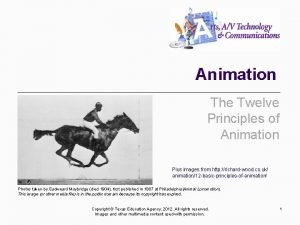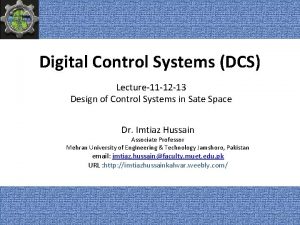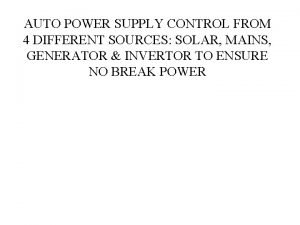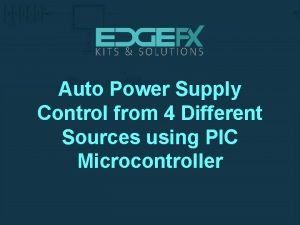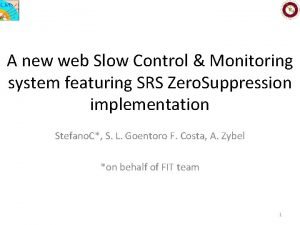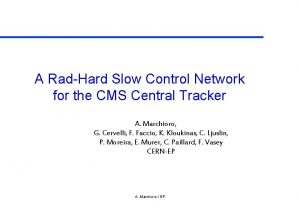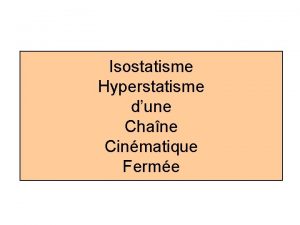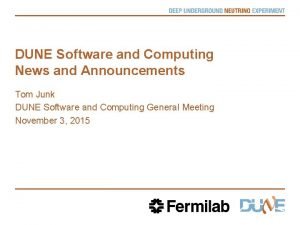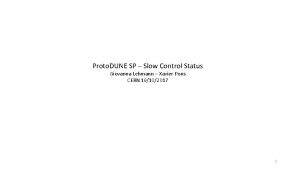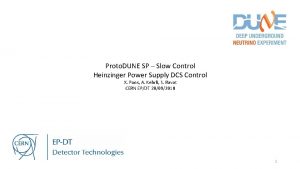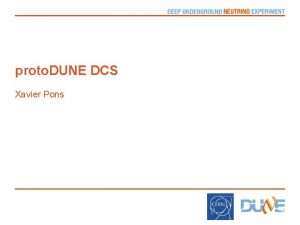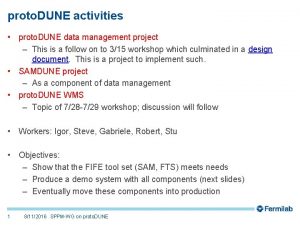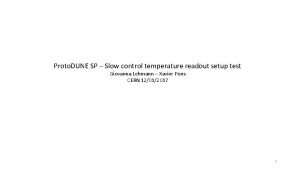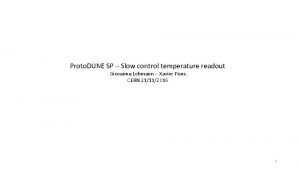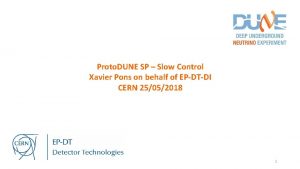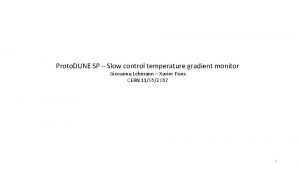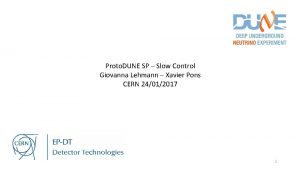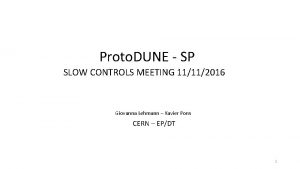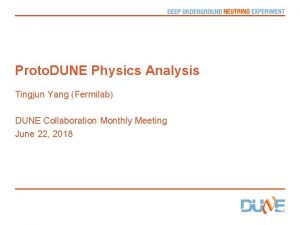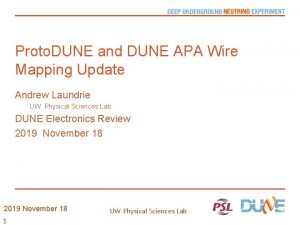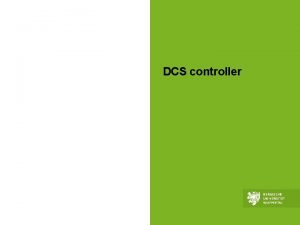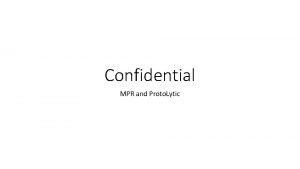Proto DUNE Slow Control Heinzinger Power Supply DCS
















- Slides: 16

Proto. DUNE – Slow Control Heinzinger Power Supply DCS Control X. Pons on behalf of EP-DT-DI CERN 02/05/2019 1

1 - Device to Control Heinzinger Technical Data Options 2

2 - Why using analogue control? Since beginning of 2018 in discussions with Heinzinger Company in order to chose the best method for the HV power supply control 3

3 - How to Control DCS adjusts by voltage, limiting the current: HEINZINGUER Sub-D 15 - Analogue control - DCS assigns a U-Ref (Pin 8 -Pin 3) a 0 -10 V =>> 0 -300 k. V AO 0 - DCS Assigns a I-Ref (Pin 7 -Pin 3) a 0 -10 V =>> 0 -500 u. A AO 1 - DCS reads the I-mon (Pin 1 -3) AI 0 - DCS reads the V-mon (Pin 2 -3) AI 1 Heinzinguer Sub-D 15 signal mapping View Heinzinguer Sub-D 15 signal mapping 4

3 - How to Control Normal operation – Voltage Regulation Overcurrent (Streamer) – Current Regulation System Voltage Current limit Voltage Setpoint Over. Current limit System Voltage Detector Current below Current limit In the normal operation the System Current < Current limit (by DCS) The Heinzinger regulates according the Voltage Setpoint assigned by DCS in the Analogue Connector During an overcurrent (streamer) System Current = Current limit (by DCS) The Heinzinger regulates according the Current Limit Setpoint assigned by DCS in the Analogue Connector and the voltage is regulated by the power supply just o keep the system current below the Current Limit 5

4 - DCS Heizinger Control Hardware. Compact RIO DCS includes a National Instrument c. RIO-FPGA 9039 controller (link) with the following I/O modules 1 - Analogue input module NI 9239 (link) 4 channels ± 10 V 24 -bits 2 - Analogue Output Module NI 9269 (link) 4 channels ± 10 V 16 -bits 3 - Analogue Input Module NI 9220 (link) 16 channels ± 10 V, 100 k. S/s/ch, 16 -Bit (Ground Planes) 4 - DI/DO Module NI 9375 (link) Digital control bits Heinzinguer DCS c. RIO control crate Detail of DCS c. RIO controller 6

4 - DCS Heizinger Control Software WINCC DCS - The control process (AI reading/AO writing; voltage setpoint, Current Limit, Current Trip) is executed inside the CRIO-FPGA in a 1 ms loop. - The data is transmitted to Real-Time controller, connected and integrated to the WINCC DCS program by means of the OPC UA driver, allowing the control, operation and survey. - The DCS system provides the HV status for monitoring and diagnostics in 3 different formats DCS slow acquisition EVENT log OPC UA c. RIO Heinzinger Controller AI/AO Hardware signals Fast acquisition Heinzinger Power Supply 7

DCS Heizinger Control Software Fastacq file The Heinzinger HV c. RIO control software includes the option generating a file saved at 20 k. Hz in case of an ‘event’. The data file includes a pretrigger of 1 second and 5 seconds after trigger At the beginning this functionality was foreseen for the Ground Planes, triggering according the conditions defined a DCS. Later, the Heinzinger Voltage, Current and the Beam plug current have been included in the Fastacq file Ground Planes Fastacq file ‘event’. Heng-Ye 14. 09. 2018 Certain conditions of the Heinzinger Power Supply events (Current Trip, Current Limit (Streamer)…) are included in the trigger conditions for generating the file. Heinzinger 120 k. V ripple noise, data from Fastacq file Ground Planes Fastacq ‘event’/trigger DCS configuration panel 8

5 - DCS Heizinger Control Hardware. Compact RIO - National Instruments Compact. RIO is a rugged, reconfigurable embedded system containing three components: 1 - The Real-Time Controller contains a processor that reliably and deterministically executes Lab. VIEW Real. Time applications and offers multirate control, execution tracing, onboard data logging, and communication with peripherals. In our case we communicate with the WINCC DCS thought the OPC UA driver 2 - A reconfigurable FPGA, excels at smaller tasks that require high-speed logic and precise timing. It is directly connected to the I/O module, no control latency for system response compared to other control architectures. DCS 3 - interchangeable industrial I/O modules. http: //www. ni. com/pdf/products/us/criodevguideintro. pdf 9

5 - DCS Heizinger Control Hardware. National Instruments c. RIO - At CERN the National Instruments Compact. RIO (and the higher level PXIFPGA) technology is used for complex high speed and reliable control processes : - As example, this technology is used in the LHC collimator position control system Our team also developed the position control system for the 38 LHC Roman Pots detectors, LHCb VELO detector position control system Experimental Magnet Control and Safety Systems Beam&Detector Interlock management. CERN Atlas AFP Roman Pot inserted in the LHC Beam line An advantage using this technology in the Slow Controls is that almost all collaborators/institutes have Labview licenses In the other hand it’s quite expensive; the Single Phase only the c. RIO hardware cost is evaluated up 12000 $, taking into account that CERN has an agreement with NI. In the Single Phase, the cost was partially supported by KSU, because the Ground Planes Acquision is performed in the Heinzinger compact. RIO. CERN Atlas Solenoid Magnet Safety System 10

Backup 11

- Monitor with AI module NI 9239 24 bits over ± 10 V (bipolar) Voltage Monitor 0 - 300 k. V over 0 - 10 V the resolution is 36 m. V Current Monitor 0 – 0. 5 m. A over 0 -10 V the resolution is 0. 06 n. A - Control with AO module NI 9269 16 bits over ± 10 V (bipolar) Voltage Ref (setpoint) 0 - 300 k. V over 0 - 10 V the resolution is 9. 16 V Current Ref (Current Limit) 0 - 500 µA over 0 - 10 V the resolution is 15 n. A 12

4 - DCS Heizinger Control Software - The Heinzinger control is quite simple, it’s an open loop, just applying a Voltage setpoint and defining a specific ramp up d. V/dt. - There are 4 defined states: - Ramping - Steady (nominal) - Trip (Fault, OFF) - Recovery (Optional) - For changing from one State to another one, several pre-defined conditions have to be accomplished. - A ramp up/down can be stopped - EMERGENCY STOP button (software and Hardware) implemented and tested. Heinzinger HV DCS Control Panel - Heart beat added in order to check the communication integrity from c. RIO to DCS, useful in case of network loss, tested. - LAr Level at 7200 mm interlock included, (condition to TRIP state) 13

4 - DCS Heizinger Control Software Current Limit – Dynamic limit Heinzinger Control Parameters - A current threshold/offset is defined above the nominal current, this threshold/offset is also constant during ramping state. - Ilimit(µA) = R(system) x Voltage + C (Offset) - If the Heizinger Current reaches the Ilimit(µA) level then the voltage is automatically adjusted (decreased ) until the Heizinger current is again below the I Limit Current Trip - A current threshold is defined, beyond this limit the Heinziger trips. A time filter can be also defined in order to skip noise spikes. V ramp up (red) with the system Current (Blue) and dynamic Current Limit threshold 14

DCS Heizinger Control Software Recovery Mode The software includes an optional ‘Automatic Recovery’ routine. The Heinzinger Power supply recovers the nominal voltage after a ‘streamer’ effect by an automatic DCS sequence without the shifter intervention Sequence Single Phase HV streamer on 11/03/2019 at 03: 20 AM 1 - Current > Current Limit more than T 1 (15 sec) 2 - Streamer 3 - Set Bias Voltage to ½ of nominal and send ACK to DCS 4 - Bias Voltage OK (DCS ACK) 5 - Voltage Command set to predefined Value (HV Step Low 100 k. V) 6 - Stay a predefined Time (T 2 60 seconds) 7 a- If after T 2 the streamer disappears then ramp up again to HV Nominal 186 k. V with Slope d. V/dt 700 V/sec go to point 9. 7 b- If after T 2 the streamer is present then go down delta. V Step 5 k. V Repeat this operation Max Trial Number 8, until streamer disappears. 8 - When streamer disappears go back to nominal HV Nominal 186 k. V with Slope d. V/dt 700 V/sec 9 - Set the Bias voltage back to nominal Single Phase HV streamer on 11/03/2019 at 03: 20 AM 15

DCS Heizinger Control Software Recently 2 triggers generated in the Heinzinger c. RIO up to DAQ have been implemented - one when the Heizinger Power supply Streamer is detected - second one when a Ground Planes triggers 16
 Copyright
Copyright Digital control systems examples
Digital control systems examples Flex power power supply
Flex power power supply Auto power supply control from 4 different sources
Auto power supply control from 4 different sources Auto power supply from 4 different sources
Auto power supply from 4 different sources Slow control application
Slow control application Slow control application
Slow control application Ac power formula
Ac power formula Desert pavement definition
Desert pavement definition How is a sand dune formed
How is a sand dune formed Climax
Climax Dune ddl
Dune ddl Dunesoftware
Dunesoftware Sand dune migration
Sand dune migration Dune sp
Dune sp Dissertation juridique exemple
Dissertation juridique exemple Salusa secundus
Salusa secundus
